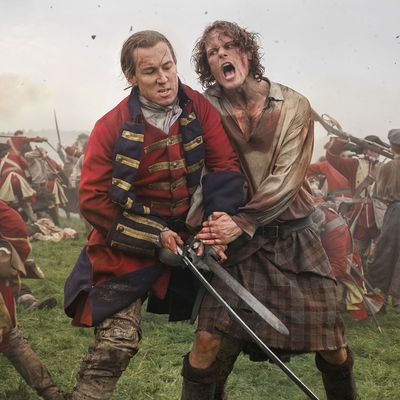
Sorry beloved Sassenachs, but the Battle of Culloden couldn’t be averted: History could not be altered, and so Claire went back to the 1940s, and Jamie went to fight against the British where he would surely die. Historically, the Battle of Culloden was the final gasp of the Jacobite rebellion — the Bonnie Prince Charlie’s failed attempt to claim the throne of England — and because of some poor strategic decisions, ended in a massacre. That’s where the season-three premiere of Outlander begins, on a battlefield littered with dying men and corpses, Jamie lying among them.
“We are like a very well-organized army ourselves,” said Brendan Maher, who directed the episode, “The Battle Joined.” The Battle of Culloden required a massive production effort for Outlander, shooting for about nine days with 425 cast members, including Sam Heughan, who plays Jamie, and Tobias Menzies, who plays his nemesis Black Jack Randall, assembled on the outskirts of Glasgow, Scotland. The day would start with the cast in hair, makeup, and wardrobe at 4:30 a.m. so they could be ready for a 7:00 a.m. call time. All told, the days would cap at about ten hours, in part because of how grueling the production was.
Energy conservation became a top priority. For instance, in the shots where the Highlanders are charging at the British, they’re actually on a slight incline. “You’d do four, five, six charges for a shot, and everyone gets exhausted very quickly. No one likes to run all day!” said Maher. “The adrenaline is fantastic at first, but then after that it gets really hard.” So they would use three, sometimes four cameras — usually handheld — in order to get as many of the shots they could without having to do too many takes.
The duel between Jamie and Randall was also intensely physical — or as Maher describes, “man-on-man, hands-on, up-close” — and required the actors full commitment even though they both had stunt doubles.
“We had people for safety, just in case, but the nature of the work is that you want the actors to do as much as they possibly can. And because the nature of their fight is personal, the camera was up close all the time. There wasn’t the opportunity to get doubles in, nor did the actors really want them,” said Maher. “After Tobias’s first day, he slept 12 hours or something, because of the toll it took on his body. But he’s very tough.”
The scene was shot in a brighter gold because they wanted their fight to have an operatic quality. “It was about emphasizing this moment, and the passions of this moment,” said Maher. “These guys have a long relationship over the series. This was a moment where they knew that one of them, or both of them, wouldn’t survive. It wasn’t so much about politics and war — it was about their relationship.”
And then there were the parts where they got to blow stuff up. In order to simulate cannon fire, they created a minefield using steel buckets dug into the ground with the explosives in the bucket. They could then control the direction of the explosion depending on the angle of the bucket. “When the battles are going on, you walk every single person involved in the action through that minefield, and then you have special-effects guys standing on the metal buckets. They throw their hands up in the air and say Bang!” said Maher. “We do that several times and we work out the safety issues with our cast and crew and cameras. And then we do the take, and the explosions go off. It’s just fantastic.”

